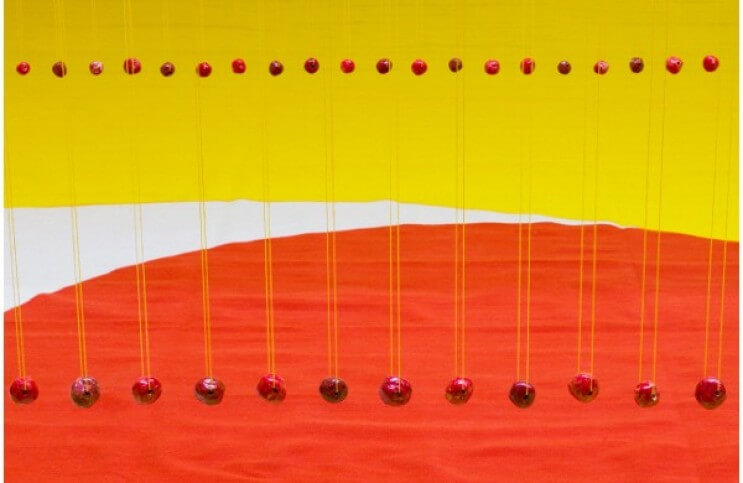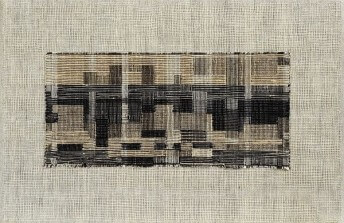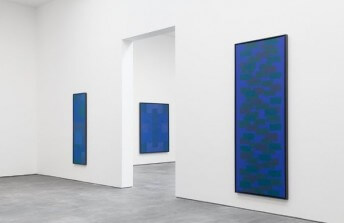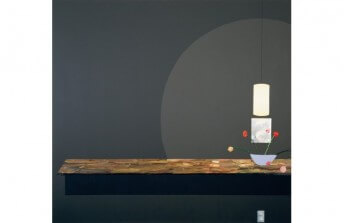The Magic of Polly Apfelbaum’s Installations in Vienna
Jan 15, 2018
Polly Apfelbaum installations are oft described in mythic terms. In 2016, art critic Christopher Knight, writing for the Los Angeles Times, described the Apfelbaum installation Face (Geometry) (Naked) Eyes as “a secular chapel.” Knight compared the hand-woven rugs, ceramic wall tablets, hanging ceramic beads, and carved wooden faces comprising the installation to religious totems, calling the overall work “a transcendent doorway to the infinite.” The year after that installation, Apfelbaum followed up with an installation that actually did inhabit a religious space. Life is Not Black and White filled the Saint-Jean Chapel in The Sourn, Brittany, with a mesmerizing assortment of objects, including a cryptic, symbolic alphabet on one wall, a shelf displaying ecclesiastical-looking art implements, and several rows of dangling, brightly colored, geometric ceramic forms. The installation did not just occupy the neo-gothic interior—it fulfilled the space, like a revelatory materialization of what must have been the purpose of its construction all along. But Apfelbaum does not attribute her work to anything religious. Her inspiration comes from Modernist abstraction, the history of craft, andher interest in new materials and processes. And her intentions are equally straightforward—she simply strives to keep things fresh and push herself beyond where she has gone before. So why does her work invite comparisons to magical, sacred things? Perhaps because it is holistic, ever-changing, and open—three qualities most of us may not share, but which we attribute to the angels of our highest nature.
The Sanctity of Meaninglessness
Certainty can be both a comfort and a scourge. It offers peace of mind, but it can also cause us to shut off our mind. For Apfelbaum, certainty is poison. In an interview she recorded several years ago with Amanda Browder on the Bad At Sports podcast, Apfelbaum referenced her 2003 mid-career survey at the Institute of Contemporary Art, Philadelphia. She said that although it was an honor, it threatened to become the death of her creative process. It was as though up to that point she had not thought about what she was doing from a wide perspective; or at least she had not thought about it in terms of what exactly it all meant, or what all the different works had to do with each other. She was mostly just being spontaneous, exploring ideas, and following her vision. Going back and organizing the past, seeing all of her previous accomplishments together in one place, gave her a chilling sense of concretion.
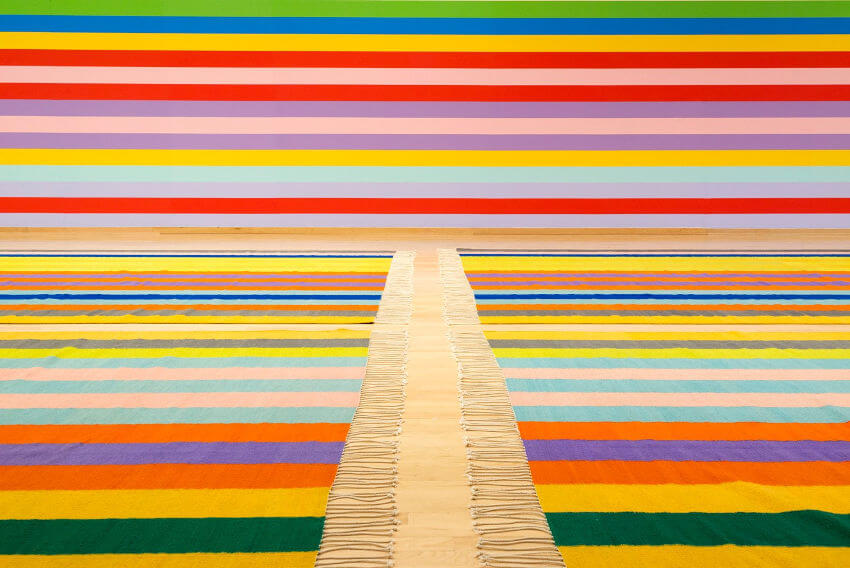 Polly Apfelbaum - For the love of Gene Davis, 2014, Courtesy the artist, Galerie nächst St. Stephan, Alexander Gray Associates and Frith Street Gallery, Alexander Gray Associates, New York
Polly Apfelbaum - For the love of Gene Davis, 2014, Courtesy the artist, Galerie nächst St. Stephan, Alexander Gray Associates and Frith Street Gallery, Alexander Gray Associates, New York
For years afterward, Apfelbaum had difficulty moving past herself. To get back to the abstract essence that had once propelled her forward, she found she had to intentionally challenge herself to break out of her comfort zone. She describes wanting to make what she did not see, “to open up the work to what I did not know.” Her quest to get back to where the work could have an unclear meaning, or perhaps even be meaningless, led her sometimes to wonder if what she was making could even be called art. The work existed, she said, in a sort of “in between” space. But she embraced the sanctity of that unknown space. The thought of instigating undefinable, unquantifiable aesthetic phenomena was an inspiration. It renewed her sense of freedom and allowed her to break free of the quagmire of self-reflection.
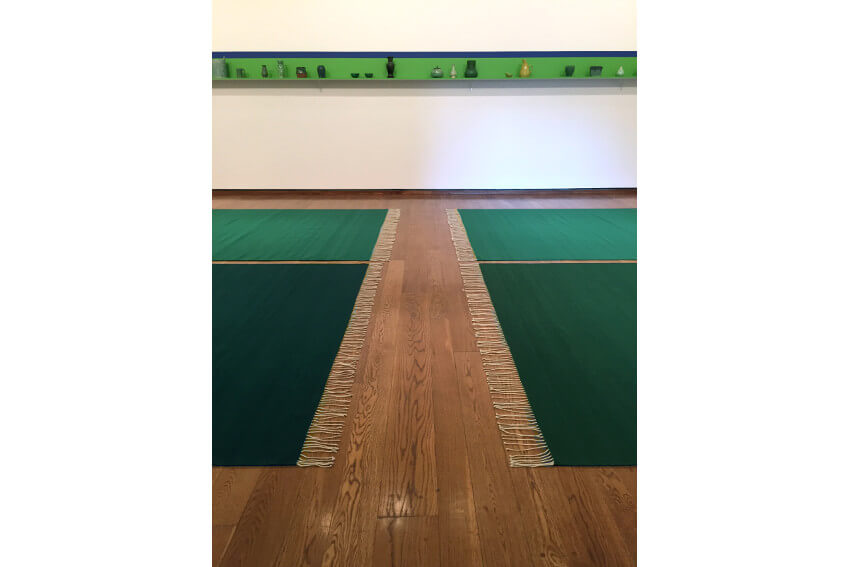 Polly Apfelbaum - Evergreen (Blue Shoes) 2015, Courtesy the artist, Galerie nächst St. Stephan, Alexander Gray Associates and Frith Street Gallery, Everson Museum of Art, Syracuse, New York
Polly Apfelbaum - Evergreen (Blue Shoes) 2015, Courtesy the artist, Galerie nächst St. Stephan, Alexander Gray Associates and Frith Street Gallery, Everson Museum of Art, Syracuse, New York
Look Out Ahead
This autumn, Apfelbaum may once again find herself facing the threat of concretion. Beginning 7 September 2018, the Belvedere 21 museum in Vienna will exhibit for the first time several of her large-scale installations in the same space at one time. It is an experimental idea—each of the installations that will be on view was originally created in response to some other specific site. Bringing these disparate works into dialogue with each other in a massive, sun-lit, Modernist pavilion possibly runs contrary to their raison d'être. But in a spectatorial sense, it is also a wonderful opportunity to examine the connective threads between the works. It could no doubt open doors of perception to those seeking ways of placing Apfelbaum in a historical aesthetic lineage. I would love to attend for that very reason. But I wonder—will Apfelbaum be there? Will she interpret this exhibition as a possibility for a new spark, or could it present to her another analytical threat to the spontaneity that sustains her progress?
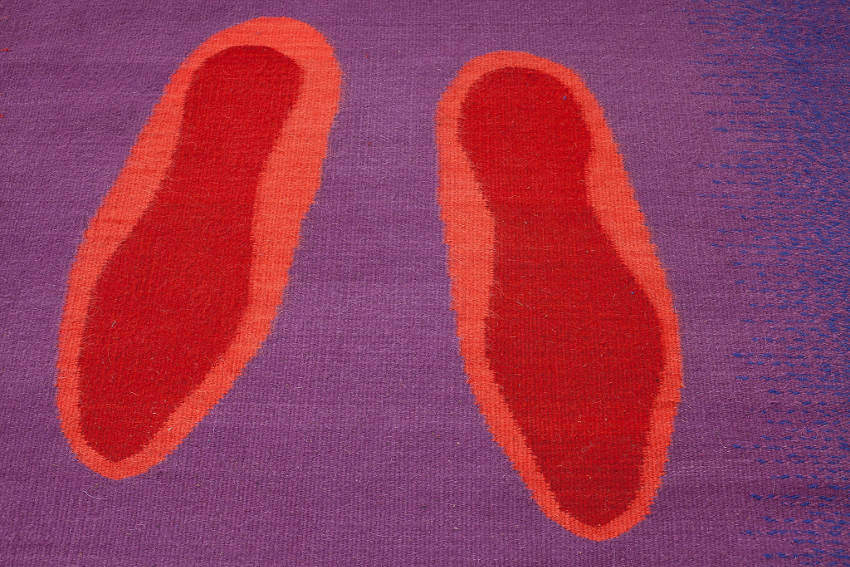 Polly Apfelbaum - Deep purple, Red Shoes, 2015, Courtesy the artist, Galerie nächst St. Stephan, Alexander Gray Associates and Frith Street Gallery, Be-Part, Wareham, Belgium
Polly Apfelbaum - Deep purple, Red Shoes, 2015, Courtesy the artist, Galerie nächst St. Stephan, Alexander Gray Associates and Frith Street Gallery, Be-Part, Wareham, Belgium
I hope she will see this unique exhibition as something positive. When I look back at the work Apfelbaum has done, I do not get a sense of concretion. I see endless variety and freshness. I see an artist intent on using every facet of the physical world in her work. Apfelbaum sees all surfaces and all spaces as her supports. Without pretense, she effortlessly eliminates all barriers between mediums, and all distinctions between dimensions. She sees every formal element also as a conceptual one. Her work goes everywhere; it accepts whatever the reality of its environment is and manages to enhance everything in its vicinity. I have no idea what any of it means, but nor do I feel any desire or responsibility to ask. I react to her work the same way I react to glaciers, blue holes, stalagmites, or any other beautiful, complicated element of nature—I admire it, I take in the grandeur of how it fits with its surroundings, and I enjoy the pleasure of being in its presence. I rarely wonder how it got there or what could be its purpose. It just is, and for me that is enough.
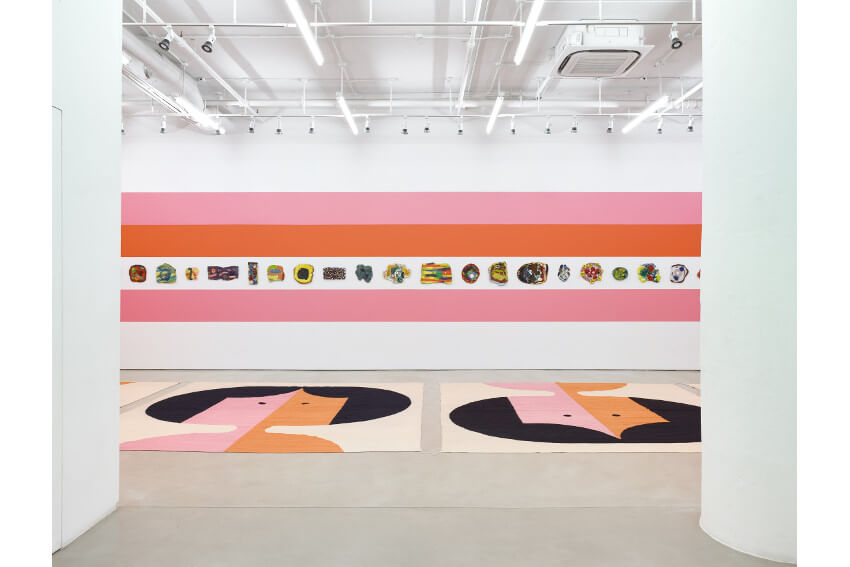 Polly Apfelbaum - The Potential of Women, 2017, Courtesy the artist, Galerie nächst St. Stephan, Alexander Gray Associates and Frith Street Gallery, Everson Museum of Art, Syracuse, New York
Polly Apfelbaum - The Potential of Women, 2017, Courtesy the artist, Galerie nächst St. Stephan, Alexander Gray Associates and Frith Street Gallery, Everson Museum of Art, Syracuse, New York
Featured image: Polly Apfelbaum - Face (Geometry)( Naked) Eyes, 2016, installation detail, dimensions variable, Courtesy the artist, Galerie nächst St. Stephan, Alexander Gray Associates and Frith Street Gallery, Ben Maltz Gallery, Otis College of Art and Design, LA, CA
All images used for illustrative purposes only
By Phillip Barcio
